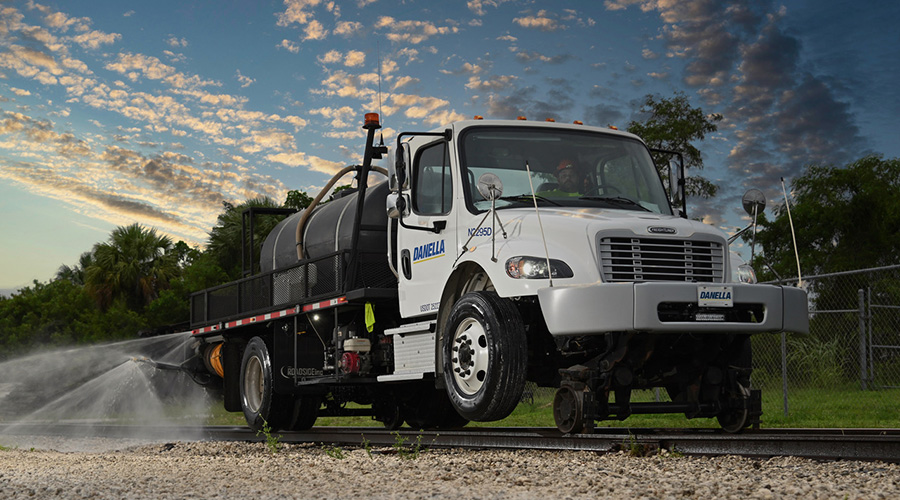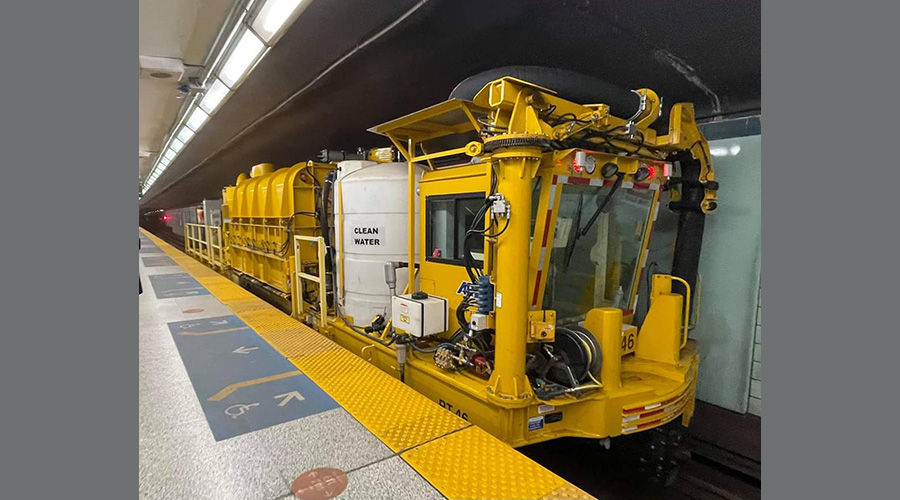Stay updated on news, articles and information for the rail industry
October 2007
Rail News: MOW
As good a time as any in the crosstie market
Spurred by record capital spending by Class Is and rising fuel prices, and largely unfettered by supply-side issues, crosstie producers this year appear poised to fashion a solid encore to last year’s high-water mark for tie purchases.
In late summer, the Railway Tie Association (RTA) predicted North American railroads this year would purchase about 20.3 million wood ties, which account for 93 percent of the tie market. That’s slightly less than the 20.7 million wood ties purchased in 2006, but a banner year, nonetheless.
That’s not to say there haven’t been a few hiccups along the way. Tie purchases slumped during the summer while production soared, driving up inventories. Meanwhile, the sluggish U.S. economy continues to do a number on railroads’ carloads. Through 2007’s first 37 weeks, U.S. railroads originated 12 million carloads, down 3.4 percent compared with traffic totals from the same period last year, according to the Association of American Railroads (AAR). Estimated volume totaled 1.24 trillion ton-miles, representing a 1.9 percent year-over-year decline.
Canadian railroads registered a 3.5 percent drop in originated carloads, which totaled 79,210 units.
No wonder, then, that RTA analysts have revised downward their procurement forecasts several times this year. Even so, optimism generally abounds in crosstie circles. The traffic totals, while down, are still strong — and they’ll continue to be, RTA believes. The association projects steady purchase levels of 20.3 million to 20.9 million ties from 2008 through 2010.
“The industry is probably in the best situation we’ve seen in the last 20 to 25 years in terms of steady-state demand,” says RTA Executive Director Jim Gauntt. “Surveys and interviews with Class I railroads indicate we’ll enjoy a period of relative stability.”
For the most part, producers of wood, concrete, steel and composite ties echo Gauntt’s assessment.
“Almost all of the Class Is and many of the short-line and regional railroads have experienced record or near-record growth in both revenue and tonnage hauled,” says Jeff Broadfoot, national account sales manager for Thompson Industries Inc., which produces pressure-treated wood crossties, and other tie and timber products. “Railroads have seized this opportunity to expand capacity by building new track and replacing worn out ties at levels we have not seen in the past 10 years.”
A perfect storm
The high cost of diesel, which continues to drive many shippers to switch from long-haul trucks to railroads, certainly hasn’t hurt. The more traffic they generate, the more railroads can reinvest in their infrastructure.
“The Class Is continue with strong maintenance-of-way programs, and the short lines and regional railroads continue to upgrade their tracks to handle larger and heavier cars,” says Tom Niederberger, vice president of marketing and sales for Koppers Inc.’s railroad products and services division.
The ethanol plant development boom in the Midwest has been a driver, too; these plants need “a lot of new trackage to get corn in and out,” says Floyd Bowlby, director of marketing for Burke-Parsons-Bowlby Corp., noting that Class Is, short lines and contractors all continue to place wood-tie orders.
If only at a slightly slower pace, adds Matt Clarke, chairman, president and chief executive officer of wood-tie producer Gross & Janes Co.
“While Class I railroads are earning above their cost of capital, they are extremely mindful of tying up capital in over-sized inventories,” Clarke says. “Demand for ties remains at very favorable levels, but it is tempered to a much higher degree than the ‘Wild West’ attitude taken 12 to 18 months ago.”
Demand may be tempered, but it’ll be consistent, producers believe — particularly if the federal tax credits for short-line and regional railroad infrastructure improvements continue to spur orders. Approved in 2004 and set to expire at the end of 2007, the tax legislation provides a 50-cent credit for every dollar spent, up to a certain cap amount.
“I believe the tax credits for short lines have freed up money for maintenance-of-way programs,” says Rick Gibson, vice president of sales for wood-tie supplier Appalachian Timber Services Inc., which this year provided ties for a range of customers, from a new ethanol plant in Indiana to seaports in New Jersey.
Favorable five-year window
Bottom line: Tie producers figure on the market being strong for the next three to five years, says George Caric, vice president of business development for wood-tie producer Tangent Rail Products, whose primary recent orders came from Canadian Pacific Railway.
“We don’t expect fuel prices to go down, so that will enable railroads to continue to make capital improvements to get better at what they do,” says Caric, who also is RTA’s current president. “I don’t think they’re at the speed they want to be at — they want to continue to improve their service, and in order to do that, they need good rail beds.”
To keep pace with current and future demand, several tie producers are ramping up capacity, particularly on the treatment front. In February, Burke-Parsons-Bowlby opened a wood treating plant in Fulton, Ky., that offers creosote and borate/creosote treatment dual treatment capabilities.
“Our wood-treating capacity was tight during the summer, but it’s better now,” Bowlby says.
Meanwhile, the installation of an additional treating cylinder increased capacity by 25 percent at Appalachian Timber’s plant in Sutton, W. Va., Gibson says. Koppers installed additional treating cylinders at plants in Galesburg, Ill., and Guthrie, Ky., and converted a pole cylinder to tie treatment at a plant in Florence, S.C., Niederberger says. And Thompson Industries will add preservative storage and a state-of-the-art overhead preservative tank car unloading facility, and upgrade all PLC and control systems at two trim-and-grade stations, Broadfoot says.
“Our company is currently treating ties 24/7,” he adds. “While treating time was tight earlier this year, we were able to stack a good number of ties for air seasoning, and have adequate cylinder space available to help us get a jump on our 2008 business.”
Tangent Rail Products operates five tie-treating plants, all of which are operating at “good levels,” Caric says. But earlier this summer, heavy rains and flooding in the southern United States temporarily disrupted the supply of ties to Tangent’s plant in Warrior, Ala.
Ties make the cut at sawmills
On the other hand, the housing slowdown gives sawmills more breathing room in terms of capacity, minimizing potential tie-supply problems.
“Overall, the lumber market is down, so sawmills are busy cutting and supplying ties,” Caric says.
At its Warren plant, Tangent this year began treating ties with sodium borate to satisfy demand from Norfolk Southern Corp. and Canadian National Railway Co. Both railroads operate in the “severe-rot zone” in the southern United States, where heat, moisture and insects take their toll on ties, Caric notes.
Prosperity hasn’t been limited to the wood-tie world alone. Concrete-tie producers also have been busy — and will continue to be for the foreseeable future.
“I think the railroads were running like mad before fuel prices went up,” says Al Smith, Rocla Concrete Ties Inc.’s manager of sales. “Trackage has been pretty heavily used for six to eight years now — the sheer volume of freight has created demand for infrastructure improvement. And indications are that our old and new customers alike
believe concrete ties are an investment that returns value when you consider the life-cycle costs.”
This year, Rocla received “a good-sized order” to supply ties for part of an extension of the New Mexico Rail Runner Express transit train from suburban Albuquerque to Santa Fe — the “single-biggest order we’ve received from a non-Class I railroad,” Smith says.
“We’re barely keeping up with demand,” he adds. “Earlier this year, we were at a point where we would have had to seriously consider whether we could take an order if an agency came out with a request for quote.”
Business is also booming for concrete-tie-producer CXT® Inc., a wholly owned subsidiary of L.B. Foster Co.
CXT® continues to supply concrete ties to Union Pacific Railroad as it expands the Sunset Route — a heavy-haul corridor between Los Angeles and El Paso, Texas — and adds capacity to the coal rail lines coming out of the Powder River Basin in Wyoming, says Mark Hammons, national sales manager.
“We could be up to 1.2 million ties this year, with about 65 percent going to Class Is,” he says.
Orders from rail-transit systems are also picking up, Hammons adds. Customers include Calgary Transit and Edmonton Light Rail Transit, both in Alberta, Canada; Sound Transit, Seattle; the Utah Transit Authority, Salt Lake City; the Tri-County Metropolitan Transportation District, Portland, Ore.; and the Regional Transportation District, Denver.
Strength in all sectors
Producers of steel and composite ties also are having banner years.
John Fox, vice president of marketing and sales at North American Railway Steel Tie Corp (NARTSCO), reports “a dramatic increase in our business this year, due to our products being an economical alternative to mainstay wood.” And 2007 will be the “best year ever” for TieTek Inc., says Alex Rankin, chief executive officer of North American Technologies Group Inc., TieTek’s parent company. TieTek manufactures composite ties out of recycled high-density polyethylene plastic and scrap tires.
“Our production is running at capacity at record levels,” Rankin says, adding that TieTek’s central production facility in Marshall, Texas, is “now operating at nameplate capacity” of 250,000 ties per year, and that the company is adding a third line to produce switch ties and special profiles for transit and other applications.
Amid the optimism, there are potential issues lurking on the legislative front that could have an impact on the market’s near-term prospects, tie producers say. For example, there are bills pending in Congress (S. 881/H.R. 1584) to extend the tax credits for Class II and Class III lines, Broadfoot says.
“Many of our short line and regional customers have directly benefited from this very important piece of legislation, which enables them to purchase ties they would not otherwise have been able to purchase,” he says. “It is very important that this tax credit ... be reauthorized so that these roads can continue to upgrade their track and haul the increasing amounts of tonnage from both their shippers and Class I connections.”
Also pending is the Freight Rail Infrastructure Capacity Expansion Act of 2007 (S. 1125/H.R. 2216), which would provide up to a 25 percent tax credit for railroads that increase freight rail capacity. Although the AAR acknowledges that railroads already have boosted capital spending by more than half as profits
improved, the organization notes that “numerous worthy projects have not been undertaken because they don’t provide a sufficient return on investment. By lowering the cost of money, investment tax incentives will increase the number of projects that can provide an adequate return on investment.”
In addition, there are the two bills currently before the House and the Senate — S. 953/ H.R. 2125, aka the Railroad Competition and Service Improvement Act of 2007 — that the rail lobby refers to as “re-regulation bills.” If passed, they’d decrease railroads’ earnings and, in turn, do a number on their ability to make badly needed capital investments, railroads say.
Meanwhile, a few pockets of softness in the market have surfaced. Although Durable Wood Products USA Inc. has “done real well” marketing bridge timbers, and has received a 6,000-tie order from the New York Metropolitan Transit Authority, domestic interest in imported Turada™ wood ties hasn’t been as strong, says Carlos Calixto Orta, one of the firm’s owners.
Turada™ ties are made from a tropical hardwood called Brazilian mora, which is naturally insect- and decay-resistant.
“We’ve been doing quite a bit of business overseas,” Orta says. “The foreign market sees much more value in tropical hardwood than the U.S. market.”
Forecast calls for mostly sunny skies
But by and large, the U.S. market outlook’s just too strong, overall, to prompt any tie producers to push the panic button. If anything, the silver linings seem to outweigh whatever dark undercurrents they’re picking up. Witness last month’s Canadian Pacific Railway-Dakota, Minnesota & Eastern Railroad Corp. merger agreement (see Industry News).
Under the proposed deal, CPR would acquire the 2,500-mile DM&E and its subsidiaries, including the Iowa, Chicago & Eastern Railroad Corp. The transaction’s terms include a $1.5 billion cash payment at closing and future contingent payments up to $1 billion; additional contingent payments totaling $350 million if construction on the DM&E’s long-proposed Powder River Basin project begins by Dec. 31, 2025.
It’s that PRB project that caught tie-producers’ attention.
“It’s a substantial project, probably around 800,000 to 1 million ties,” says Rocla’s Smith. “If the expansion [into the PRB] occurs — and I believe someone will come up with the money to make it happen — the supply side would be something else. It would make for a busy couple of years.”
That’d be on top of what’s already likely to be a busy next few years.
“Will it reach 21 million ties any time soon?” the RTA’s Gauntt asked rhetorically in a recently published market update. “That is yet to be seen, but both the surveys and the RTA forecast would suggest that while we wait for that time, tie suppliers should reap the benefits of a very steady market, near the 20.2 to 20.4 million mark. That’s a very high mark indeed, and one that should leave tie producers feeling very good about the future.”
As Tangent Rail Products’ Caric puts it: “It’s a good time to be in the railroad crosstie business.” 
Ken Wysocky is a Milwaukee-based free-lance writer.


 LRW Honors Amtrak’s Acheson As Railway Woman Of The Year
LRW Honors Amtrak’s Acheson As Railway Woman Of The Year
 From Editor-In-Chief Foran: Of Gender Equity And Inclusion
From Editor-In-Chief Foran: Of Gender Equity And Inclusion
 Spotlight On Some Of Today’s Rail Safety Products
Spotlight On Some Of Today’s Rail Safety Products
 Women of Influence in Rail eBook
Women of Influence in Rail eBook
 railPrime
railPrime








